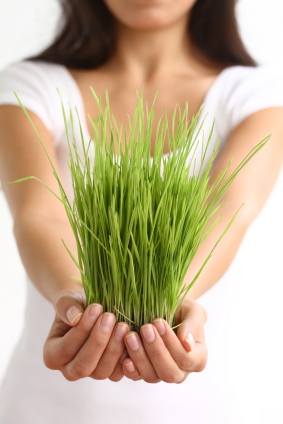How To Grow Wheatgrass – Growing Wheatgrass 101
Posted on 12. Feb, 2011 by Staff Writer Candy Del Carmen in Alkaline Foods
 Do you know that you can gain your optimal health in a form of simple wheatgrass juice? The liquid sunshine, the ultimate blood purifier, or the nectar of the Gods – that is how they call this powerful wheatgrass as it gained its popularity in diet arena. The vitality you can obtain in wheatgrass juice is very outstanding. Complete with 30 enzymes and sources of vitamins and minerals. With its enzymes and chlorophyll, wheatgrass is great body builder and detoxifier. Regular drinking of wheatgrass can fight several diseases, including obesity, bad odor, sinuses, anemia, skin problems, and reduces the risk of cancer.
Do you know that you can gain your optimal health in a form of simple wheatgrass juice? The liquid sunshine, the ultimate blood purifier, or the nectar of the Gods – that is how they call this powerful wheatgrass as it gained its popularity in diet arena. The vitality you can obtain in wheatgrass juice is very outstanding. Complete with 30 enzymes and sources of vitamins and minerals. With its enzymes and chlorophyll, wheatgrass is great body builder and detoxifier. Regular drinking of wheatgrass can fight several diseases, including obesity, bad odor, sinuses, anemia, skin problems, and reduces the risk of cancer.
However, in some countries, wheatgrass products are not frequently available; so many enthusiasts would like to do the growing of wheatgrass at the comfort of their home. Actually, wheatgrass is very simple and easy to grow. If you would like to sprout your own wheatgrass in your home, here are the simple instructions you can have and take as your guide.
Step 1: Pre-Sprouting of Wheatgrass
In order to get the complete vitamins and minerals of your wheatgrass, pre-sprouting is necessary. You can buy the organic wheatgrass seeds available in your local store. The measure of seeds will depend on the size of your tray, so do the estimation well. . First and foremost, make sure to rinse well the seeds before the pre-sprouting method. Then, make sure that your seeds are soaked for 8-10 hours in cold water to ensure that you can come up with good result. After which, there is need for you to do soak the seeds for another set of 8-10 hours. In draining the wheatgrass seeds, you can use a jar covered with cloth and rubber band or simply put the wheatgrass seed in a colander and cover it with damp towel. You may notice that the wheatgrass roots are already sprouted to ¼ of an inch.
Step 2: Preparing the Tray and Wheatgrass Seeds
You have to make sure that the roots will not protrude at the bottom, so you have to line the tray using unbleached paper towel. After which, you can now full the half inch of the tray with organic pre-moistened soil. The standard size of the tray should be 10×20 and the recommended amount of seeds has to be 12 oz or 1 ½ cup of wheatgrass seed.
Step 3: Planting the Wheatgrass
Lay out properly the germinated seeds densely in one layer, and then you can now impressed the seeds into the soil. It is much better if you can spray the soil with water before spreading the wheatgrass seed on top of the damp soil.
The environment on where to put the seeds is one of the biggest challenges for the homeowner. You may also need to determine in which location of your house would be great location. . You may put the tray inside your house or under indirect sunlight. It is the best place for your wheatgrass. Although it can be gown outdoors during spring or fall months, remember that wheatgrass cannot be exposed to over 90 degrees F, only in 60-70 degrees F.
Step 4: Watering the Wheatgrass
Water the young shoots twice a day (morning and night) in order to keep their moist. Do not let the soil gets dry. Use a spray bottle in watering the wheatgrass. You may want to cover the tray using a paper towel to keep the moisture.
When you reach the day 5, you can reduce the watering into once a day (once in the morning), but make sure that the soil remains damp to the roots. You may notice that molds may tend to grow but that will not harm your wheatgrass. Just cut above those affected areas when you harvest, to avoid the mold.
Step 5: Harvesting and Juicing the Wheatgrass
In day 9 or 10, you wheatgrass will grow in about 6-7 inches and that means for your harvest time! Use pair of scissors in cutting the wheatgrass above the seeds, one centimeter or two above the seeds. Avoid cutting the molds. It can last for a week as long as you can keep the harvested wheatgrass, as much as possible, in the coolest place. Then after cutting, you can grow again another set of wheatgrass so the nutrients of the soil are still intact and not yet depleted. The size of 21×11 tray can give you 14-18 ounces of juice. You will need simple gear juicer of wheatgrass juicer to get the full vitamins and minerals of the grass.
Growing your own wheatgrass is indeed a very challenging task, but once you get familiar with the process, rest assured that you can have your fresh supply. It is more economical than to purchase those in the form of green powdered juice or pills. Therefore, no one can stop you from getting all the health benefits from your own grown fresh harvested wheatgrass.





Recent Comments